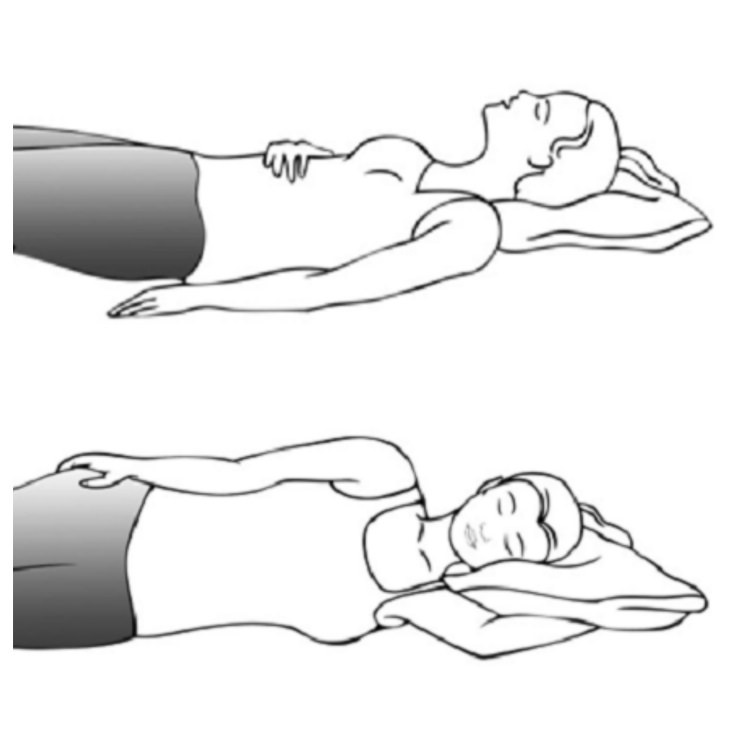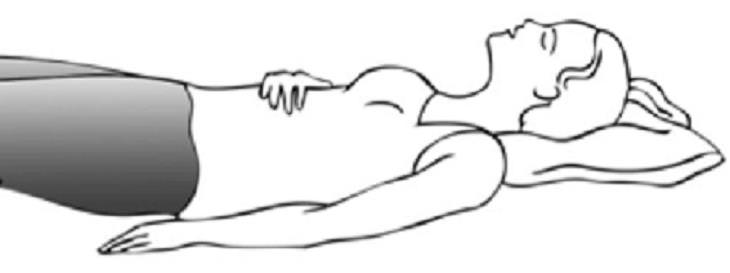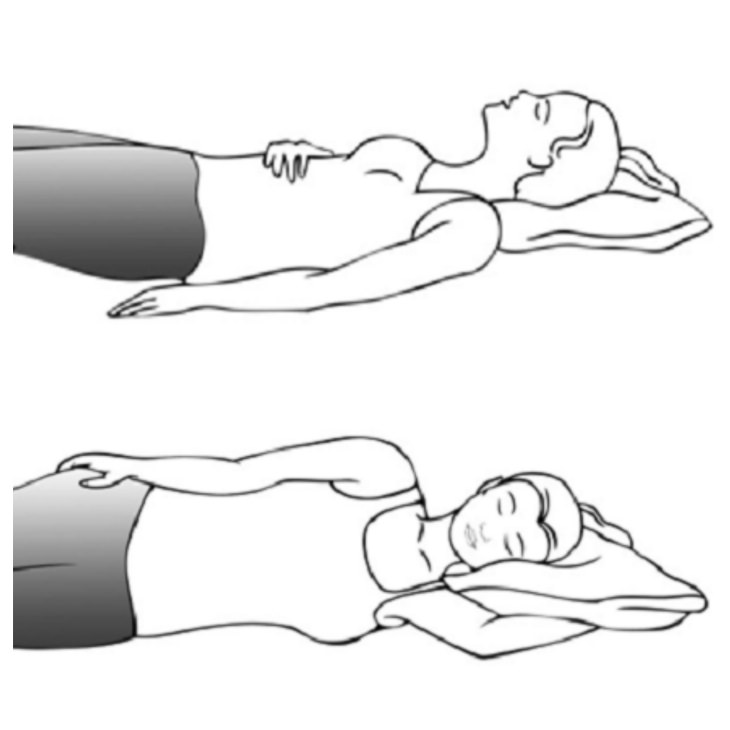Try These Sleep Positions If You Suffer From Neck, Back or Hip Pain
Estimates suggest that as much as 80 percent of adults worldwide will experience lower back pain once in their lifetime.
While certain exercises will help alleviate pain, those who suffer from chronic pain, be it in their back, neck, shoulders or hips, know that different positions can aggravate the condition, hindering sleep. In fact, according to research published in the Clinical Journal of Pain, chronic pain can negatively affect the quality of sleep, in terms of duration, satisfaction, day-time functioning, time taken to fall asleep and sleep efficiency.
These 5 sleep positions are most suitable for chronic pain sufferers:



 While sleeping on your back can
be a bad habit to get into, it has a number of benefits for TMJ
sufferers. Bear in mind the following tips:
While sleeping on your back can
be a bad habit to get into, it has a number of benefits for TMJ
sufferers. Bear in mind the following tips:
• Use a small pillow under the arch of your spine, to make back sleeping more comfortable.
• Consider changing your mattress. Opt for one that conforms to your body, making it a lot more comfortable and cozy to sleep on your back.
• Your arm position should not be overlooked. Keeping your arms at the side is best. Avoid keeping your arms over your head as this can cause strain on the shoulders.
Avoid: Sleeping on your back with your arms raised above your head, or lying on your stomach.
While certain exercises will help alleviate pain, those who suffer from chronic pain, be it in their back, neck, shoulders or hips, know that different positions can aggravate the condition, hindering sleep. In fact, according to research published in the Clinical Journal of Pain, chronic pain can negatively affect the quality of sleep, in terms of duration, satisfaction, day-time functioning, time taken to fall asleep and sleep efficiency.
Yet,
while non-neutral sleeping positions can pose unnecessary stress and
strain on the joints and surrounding tissues (which may lead to
backaches, spinal degenerative disorders and other ailments) clinicians
and researchers believe that certain sleeping positions may play a
preventive and therapeutic role in the management of backache and
chronic pain.
These 5 sleep positions are most suitable for chronic pain sufferers:
1. Neck Pain
Best sleep positions: On your side, or on your back The following tips will ensure a comfortable sleep throughout the night:
The following tips will ensure a comfortable sleep throughout the night:
 The following tips will ensure a comfortable sleep throughout the night:
The following tips will ensure a comfortable sleep throughout the night:
• Opt for a rounded pillow to support the natural curve of your neck.
• Use
a feather pillow which conforms to the shape of the neck. The drawback
is that they tend to collapse over time, in which case your pillow will
need to be replaced once a year.
• You
may also opt for a memory foam pillow that conforms to the contour of
your head and neck. It is believed that memory pillows foster proper
spinal alignment.
• Avoid
using a pillow that is too high or sticks out, as this will keep your
neck flexed overnight and can result in morning pain and stiffness.
• If you sleep on your side, opt for a pillow that is high on your neck and low on your head to keep your spine in alignment.
Avoid: Sleeping on your stomach
This
position is tough on the spine, because the back is arched and your
neck is turned to the side. While we don't often wake up in the same
position in which we fell asleep, it is worth starting the night
sleeping on your back or side in a well-supported, healthy position.
2. Shoulder Pain
Best sleep positions: On your side, or on your back

Bear in mind the above mentioned tips, alongside the following:
• Ideally keep your legs straight to minimize pressure on the spine.
• If keeping your legs extended is uncomfortable, flex the knees at a 90-degree angle to maintain a neutral posture.
Avoid: Sleeping on your side without pillow support.
3. Low back pain
Best sleep position: On your back with pillows placed underneath your knees.

This sleeping position minimizes back arching, reducing low back pain.
• When
sleeping on your back, avoid crossing your legs or sliding one knee
over the other as this increases the pressure on your pelvis.
• Avoid a thick pillow and do not use more than one pillow when resting in this position.
• For
extra comfort, and to reduce the pressure of gravity, you can use soft
physical support in the form or rolled up towels or pillows at positions
where your spine tends to naturally curve - predominantly at the lower
back and under the knees.
• Keep your arms parallel to your torso as opposed to being elevated above your head.
Avoid: Sleeping on your stomach or on your back without a pillow underneath your knees.
4. Hip Pain
Best sleep positions: On your side, with a pillow placed between the knees.

Sleeping with a pillow between your knees has a number of benefits:
• It will prevent your upper leg from pulling your spine out of alignment.
• It will reduce stress on your hips and lower back.
• It will help pull your knees up slightly toward your chest.
• Opt for a firm pillow.
Avoid: Sleeping on your back or stomach.
5. Jaw Pain, TMJ (Temporomandibular Joint Syndrome) and Headaches
Best sleep position: On your back, with arms at the side. Use a TMJ-friendly pillow.

• Use a small pillow under the arch of your spine, to make back sleeping more comfortable.
• Consider changing your mattress. Opt for one that conforms to your body, making it a lot more comfortable and cozy to sleep on your back.
• Your arm position should not be overlooked. Keeping your arms at the side is best. Avoid keeping your arms over your head as this can cause strain on the shoulders.
Avoid: Sleeping on your back with your arms raised above your head, or lying on your stomach.
THIS IS ONLY FOR INFORMATION, ALWAYS CONSULT YOU PHYSICIAN BEFORE
HAVING ANY PARTICULAR FOOD/ MEDICATION/EXERCISE/OTHER REMEDIES.
PS-
THOSE INTERESTED IN
RECIPES ARE FREE TO VIEW MY BLOG-
https://gseasyrecipes.blogspot.com/
FOR INFO ABOUT KNEE
REPLACEMENT, YOU CAN VIEW MY BLOG-
https:// kneereplacement-stickclub.blogspot.com/
FOR CROCHET DESIGNS https://gscrochetdesigns.blogspot.com
Labels: avoid sleeping on stomach, back or hip pain, headache, memory pillow, natural curve, neck, pillow under knees, rounded pillow, shoulder pain, side / back, sleep position, supports, TMJ

0 Comments:
Post a Comment
<< Home